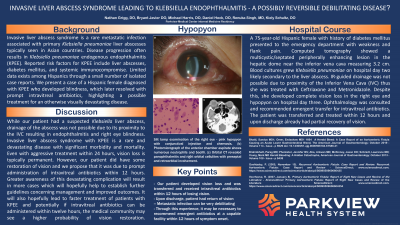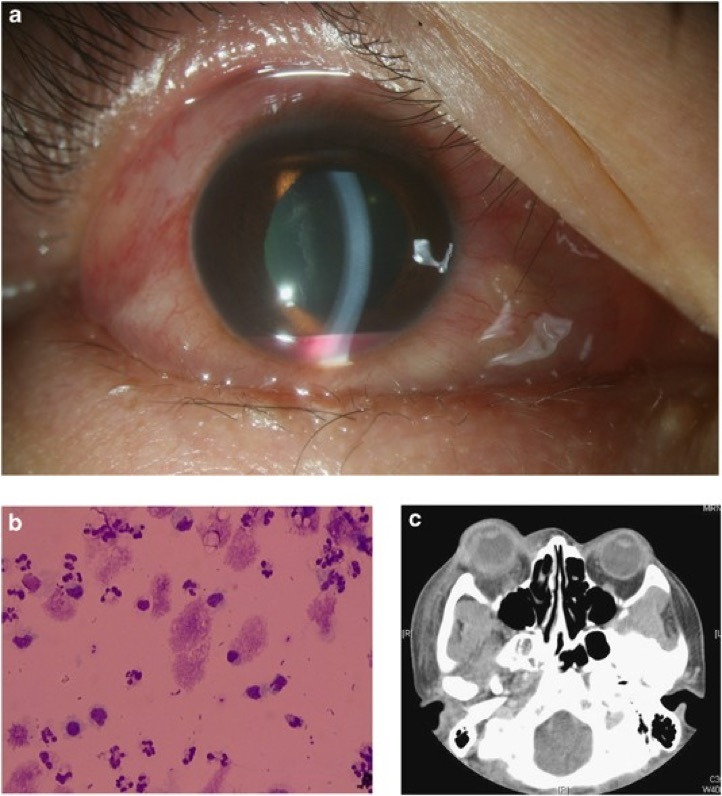Back


Poster Session C - Monday Afternoon
Category: Liver
C0621 - Invasive Liver Abscess Syndrome Leading to Klebsiella Endophthalmitis - A Possibly Reversible Debilitating Disease?
Monday, October 24, 2022
3:00 PM – 5:00 PM ET
Location: Crown Ballroom

Has Audio
- NG
Nathan Grigg, DO
Parkview Medical Center
Pueblo, CO
Presenting Author(s)
Nathan Grigg, DO, Bryant Javier, DO, Michael Harris, DO, Daniel Heck, DO, Renuka Singh, MD, Kiely Schultz, DO, Kourtney Aylor-Lee, DO
Parkview Medical Center, Pueblo, CO
Introduction: Invasive liver abscess syndrome is a rare metastatic infection associated with primary Klebsiella pneumoniae liver abscesses typically seen in Asian countries. Disease progression often results in Klebsiella pneumoniae endogenous endophthalmitis (KPEE). Reported risk factors for KPEE include liver abscesses, diabetes mellitus, and systemic immunocompromise. Limited data exists among Hispanics through a small number of isolated case reports. We present a case of a Hispanic female diagnosed with KPEE who developed blindness, which later resolved with prompt intravitreal antibiotics, highlighting a possible treatment for an otherwise visually devastating disease.
Case Description/Methods: A 75-year-old Hispanic female with history of diabetes mellitus presented to the emergency department with weakness and flank pain. Computed tomography showed a multicystic/septated peripherally enhancing lesion in the hepatic dome near the inferior vena cava measuring 3.2 cm. Blood cultures grew Klebsiella pneumoniae on hospital day two likely secondary to the liver abscess. IR-guided drainage was not possible due to proximity of the Inferior Vena Cava (IVC) thus she was treated with Ceftriaxone and Metronidazole. Despite this, she developed complete vision loss in the right eye and hypopyon on hospital day three. Ophthalmology was consulted and recommended emergent transfer for intravitreal antibiotics. The patient was transferred and treated within 12 hours and upon discharge already had partial recovery of vision.
Discussion: While our patient had a suspected Klebsiella liver abscess, drainage of the abscess was not possible due to its proximity to the IVC resulting in endophthalmitis and right eye blindness. Invasive liver abscess syndrome with KPEE is a rare and devastating disease with significant morbidity and mortality. Even with aggressive treatment within 24 hours, vision loss is typically permanent. However, our patient did have some restoration of vision and we propose that it was due to prompt administration of intravitreal antibiotics within 12 hours. Greater awareness of this devastating complication will result in more cases which will hopefully help to establish further guidelines concerning management and improved outcomes. It will also hopefully lead to faster treatment of patients with KPEE and potentially if intravitreal antibiotics can be administered within twelve hours, the medical community may see a higher probability of vision restoration.

Disclosures:
Nathan Grigg, DO, Bryant Javier, DO, Michael Harris, DO, Daniel Heck, DO, Renuka Singh, MD, Kiely Schultz, DO, Kourtney Aylor-Lee, DO. C0621 - Invasive Liver Abscess Syndrome Leading to Klebsiella Endophthalmitis - A Possibly Reversible Debilitating Disease?, ACG 2022 Annual Scientific Meeting Abstracts. Charlotte, NC: American College of Gastroenterology.
Parkview Medical Center, Pueblo, CO
Introduction: Invasive liver abscess syndrome is a rare metastatic infection associated with primary Klebsiella pneumoniae liver abscesses typically seen in Asian countries. Disease progression often results in Klebsiella pneumoniae endogenous endophthalmitis (KPEE). Reported risk factors for KPEE include liver abscesses, diabetes mellitus, and systemic immunocompromise. Limited data exists among Hispanics through a small number of isolated case reports. We present a case of a Hispanic female diagnosed with KPEE who developed blindness, which later resolved with prompt intravitreal antibiotics, highlighting a possible treatment for an otherwise visually devastating disease.
Case Description/Methods: A 75-year-old Hispanic female with history of diabetes mellitus presented to the emergency department with weakness and flank pain. Computed tomography showed a multicystic/septated peripherally enhancing lesion in the hepatic dome near the inferior vena cava measuring 3.2 cm. Blood cultures grew Klebsiella pneumoniae on hospital day two likely secondary to the liver abscess. IR-guided drainage was not possible due to proximity of the Inferior Vena Cava (IVC) thus she was treated with Ceftriaxone and Metronidazole. Despite this, she developed complete vision loss in the right eye and hypopyon on hospital day three. Ophthalmology was consulted and recommended emergent transfer for intravitreal antibiotics. The patient was transferred and treated within 12 hours and upon discharge already had partial recovery of vision.
Discussion: While our patient had a suspected Klebsiella liver abscess, drainage of the abscess was not possible due to its proximity to the IVC resulting in endophthalmitis and right eye blindness. Invasive liver abscess syndrome with KPEE is a rare and devastating disease with significant morbidity and mortality. Even with aggressive treatment within 24 hours, vision loss is typically permanent. However, our patient did have some restoration of vision and we propose that it was due to prompt administration of intravitreal antibiotics within 12 hours. Greater awareness of this devastating complication will result in more cases which will hopefully help to establish further guidelines concerning management and improved outcomes. It will also hopefully lead to faster treatment of patients with KPEE and potentially if intravitreal antibiotics can be administered within twelve hours, the medical community may see a higher probability of vision restoration.

Figure: Slit-lamp examination of the right eye - hypopyon with conjunctival injection and chemosis. (b) Photomicrograph of the anterior chamber aspirate shows numerous neutrophils and bacilli. (c) Orbital CT revealed panophthalmitis and right orbital cellulitis with preseptal and retroorbital involvement.
Disclosures:
Nathan Grigg indicated no relevant financial relationships.
Bryant Javier indicated no relevant financial relationships.
Michael Harris indicated no relevant financial relationships.
Daniel Heck indicated no relevant financial relationships.
Renuka Singh indicated no relevant financial relationships.
Kiely Schultz indicated no relevant financial relationships.
Kourtney Aylor-Lee indicated no relevant financial relationships.
Nathan Grigg, DO, Bryant Javier, DO, Michael Harris, DO, Daniel Heck, DO, Renuka Singh, MD, Kiely Schultz, DO, Kourtney Aylor-Lee, DO. C0621 - Invasive Liver Abscess Syndrome Leading to Klebsiella Endophthalmitis - A Possibly Reversible Debilitating Disease?, ACG 2022 Annual Scientific Meeting Abstracts. Charlotte, NC: American College of Gastroenterology.
